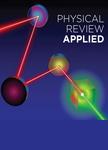版权所有:内蒙古大学图书馆 技术提供:维普资讯• 智图
内蒙古自治区呼和浩特市赛罕区大学西街235号 邮编: 010021

作者机构:Department of Electrical and Computer Engineering University of Nebraska-Lincoln Lincoln Nebraska 68588 USA Department of Materials Science and Engineering Massachusetts Institute of Technology Cambridge Massachusetts 02139 USA Department of Physics Universidad Técnica Federico Santa María 2390123 Valparaíso Chile
出 版 物:《Physical Review Applied》 (Phys. Rev. Appl.)
年 卷 期:2018年第10卷第3期
页 面:034043-034043页
核心收录:
基 金:MISTI Proyecto Basal, (FB 0821) Fondo Nacional de Desarrollo Científico y Tecnológico, FONDECYT, (1140552) Fondo Nacional de Desarrollo Científico y Tecnológico, FONDECYT
主 题:Antiferromagnetism Exchange bias Impedance Magnetic anisotropy Skin effect Magnetic multilayers Soft magnets Solid-state detectors
摘 要:The dependence of the asymmetric magnetoimpedance (MI) response on the directions of both the magnetic field and the exchange bias is studied for an [Ni−Fe(60nm)/Ir−Mn(35nm)]×5 multilayer system. The antiferromagnetic (AFM) layers create an exchange bias that shifts both the hysteresis loop and the MI response of Ni−Fe; the strength of this coupling depends on the thicknesses of both the ferromagnetic layer and the AFM layer. Tuning the exchange-bias angle and the applied-magnetic-field direction provides a practical method to control the symmetry and the magnitude of the MI response. The observed asymmetric response can be attributed to the coexistence of two anisotropies, the induced exchange-bias anisotropy and the magnetocrystalline anisotropy. Both are distinct components of the exchange-coupled Stoner-Wohlfarth energy density that forms a basis for simulations within the conventional Landau-Lifshitz-Gilbert framework. The model reproduces the main features of the experimental results, providing a deeper understanding of the effect of the anisotropy components on the MI characteristic curve and ratio. The results can be used for the development of an asymmetric MI exchange-biased thin-film element in an autobiased linear-magnetic-field sensor.